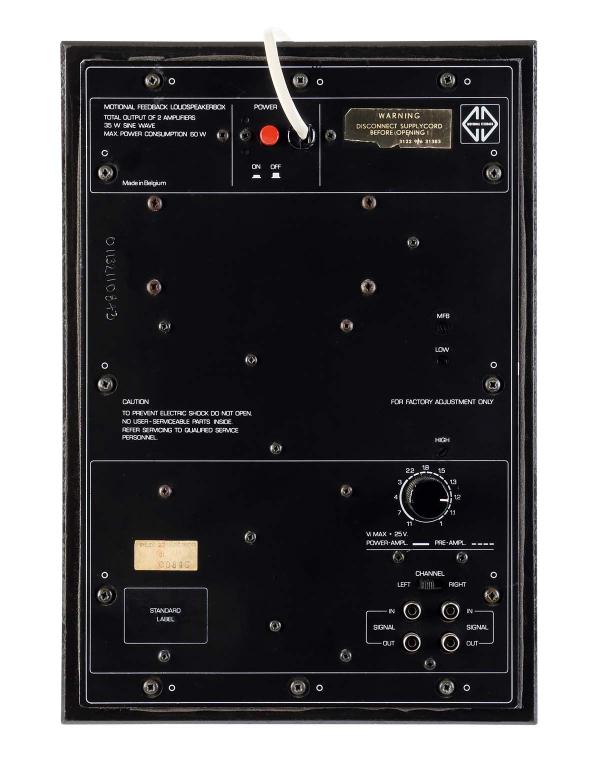Philips AH585 loudspeaker Page 3

Tim Listens
If the intention here was to produce a speaker that combined the advantages of the MFB process with a more ‘normal’ sound then it can be considered a success. The older RH532 sounds startlingly different to everything else (with the possible exception of real live music) but while the AH585 is less of a shock, it sounds more familiar. This is not to downplay its qualities – another key virtue is stereo depth and imaging, both of which rapidly coalesce without the need for intense concentration by the listener.
Clever though MFB is, it is not magic, and one must remember that these are small loudspeakers in small sealed cabinets – they need to be located reasonably close to the wall behind them to help get the bass out into the room. Care here is vital as it’s easy to smother the tight, tuneful ‘MFB sound’ in thick, reinforcement-originated boom. The other end of the scale is far simpler as Philips’ tweeter simply shines in this application. It is easy to forget how normal crossovers and cables can blunt the performance of a tweeter, but having no coupling components and only about 30cm of wiring between the AH585’s driver and its dedicated amplifier makes the treble extremely vivid and super-fast. Stands that see the tweeters positioned at near ear-level height are ideal.
An appropriate musical challenge for the AH585s was Kraftwerk’s ‘Trans-Europe Express’ [Capitol CDP 7 46473 2], a piece which normally only makes any sense at all when played pretty loudly through large loudspeakers. Of course, it was the MFB-reinforced bassline I was listening for, but what actually grabbed my attention was the sharpness of the electronic percussion, even at low listening. The bass had its chance in the following track, ‘Metal On Metal’, and yes, it was still deep, rich and well defined. I felt that the 30+5W rating was well chosen in this design, although it was odd that the treble seemed to run out of headroom before the bass (albeit at a point where the sound as a whole was deafeningly loud). Typically, it’s the other way around.
Acoustic material showed the AH585’s tonal balance to be essentially neutral but overlaid with the distinctive MFB signature of bass that is both a little ‘tubby’ but very well defined. Each note was rendered as subtly different rather than gathered around a fixed port resonance. ‘On Every Street’ by Dire Straits [Vertigo 510160-2] sounded slightly warm, but it was elevated by that odd MFB trick of making it sound as if one is listening at the desk in the recording studio rather than to a finished recording at home.
No Return
The final proof of the ‘rightness’ of this design is that it is difficult to go back to listening to conventional loudspeakers. At any price, I always felt I was missing something. Unlike the early Philips MFB designs, these late models are less a means of demonstrating the possibilities of advanced technology and more a practical packaging of the techniques to create a more ‘normal’ loudspeaker of exceptional quality. It works.
Buying Secondhand
While plentiful on the Continent, all third-generation Philips MFB speakers are hard to find in the UK. Reliability is good, but this period of Philips production is well known for problems with soldering, so any fault investigation should start with a search for poor joints. The speaker relay is another common trouble spot – it is not easy to access but once removed it can be dismantled for cleaning. The quality of all the passive components is top rate so there is no need to replace any of these simply for the sake of it.
One thing that does seem to deteriorate is the MFB sensor itself. Reduced output means the system becomes less effective, resulting in bloated bass and little in the way of MFB action. There is a preset control at the rear of the unit which will compensate for this, the correction normally being well within the adjustment range. Even though the amplifiers are DC-coupled there is no need to zero the midpoint voltage as this is done automatically. The bias does need to be set though, and it is worth checking, as many of these units will have received no attention since they were made.
Hi-Fi News Verdict
While not as quirky as the original incarnations of Philips’ MFB, the AH585 is still a special loudspeaker that is well worth hearing if you get the chance. MFB is only part of the story, of course, because the well resolved electronics, well-made cabinets and high-quality drive units all contribute to a fine level of performance. Easy system matching makes trying a pair relatively straightforward.
Sound Quality: 85%


















































